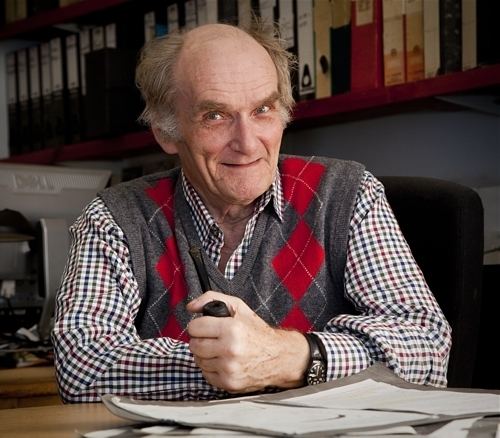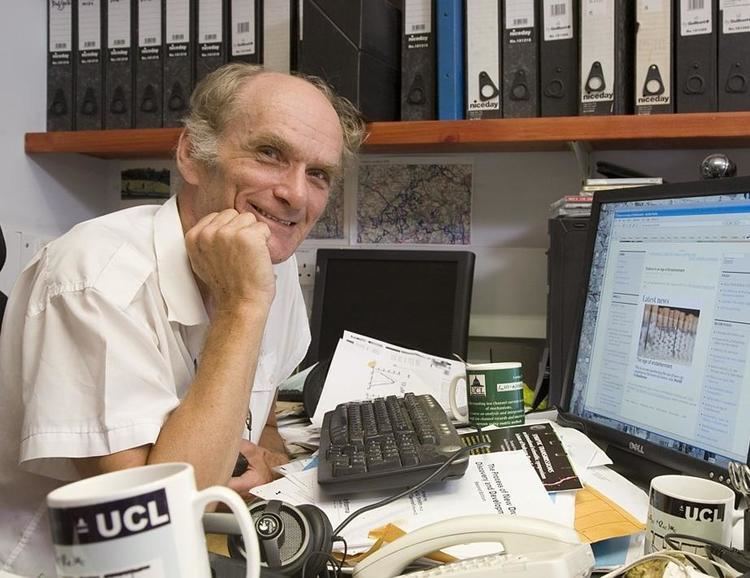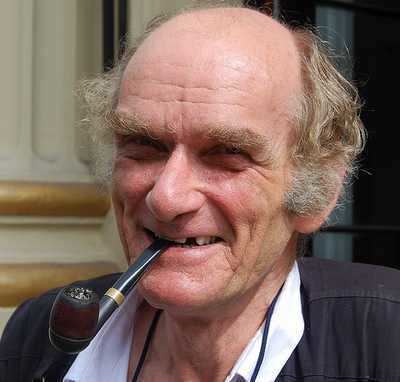Name David Colquhoun Role University Professor | Books Lectures on biostatistics | |
 | ||
Institutions Yale UniversityUniversity of SouthamptonUniversity College London Thesis The characterisation and adsorption of sensitising antibodies (1965) Known for Single Ion channelsCriticism of pseudo-science Notable awards FRS (1985)Humboldt Prize (1990) Fields Pharmacology, Biophysics, Stochastic process | ||
Professor david colquhoun interview full
David Colquhoun, (born 19 July 1936) is a British pharmacologist at University College London (UCL). He has contributed to the general theory of receptor and synaptic mechanisms, and in particular the theory and practice of single ion channel function. He previously held the A.J. Clark chair of Pharmacology at UCL, and was the Hon. Director of the Wellcome Laboratory for Molecular Pharmacology. He was elected a Fellow of the Royal Society (FRS) in 1985 and an honorary fellow of UCL in 2004. Colquhoun runs the website DC's Improbable Science, which is critical of pseudoscience, particularly alternative medicine, and managerialism. He was critical of Tim Hunt following the controversies of the 2015 World Conference of Science Journalists in Seoul.
Contents
- Professor david colquhoun interview full
- Science in an age of endarkenment david colquhoun part1
- Early life and education
- Scientific career
- Work with single ion channels
- Missed short events
- Intermediate shut states
- Statistical inference
- Criticism of scientific fraud alternative medicine and managerialism
- DCs Improbable Science website
- Controversy over website hosting
- Alternative medicine and the government
- Awards and honours
- Personal life
- References

Science in an age of endarkenment david colquhoun part1
Early life and education

Colquhoun was born on 19 July 1936 in Birkenhead, UK. He was educated at Birkenhead School and Liverpool Technical College. After working unhappily as an apprentice pharmacist, he was motivated to go into research. He obtained a BSc from the University of Leeds with a specialisation in pharmacology, and went on to complete a PhD at the University of Edinburgh where he studied the binding of immunoglobulins to lung tissue. During his education, Colquhoun developed an interest in statistics and random processes, which would influence his research in years to come.

Upon completion of his PhD, Colquhoun conducted further research on immunological problems at UCL from 1964 to 1969. During this time he published a book on statistics. Following this, he completed stints at Yale University and at the University of Southampton. He returned to the pharmacology department at UCL in 1979, where he has remained since. In 2007, Malcolm Grant destroyed that department, ending its eminent 102-year history (see Department of Pharmacology at University College London, 1905 – 2007).
Scientific career
Colquhoun researched the nature of the molecular interactions that cause single ion channels to open and shut, and what it is that controls the speed of synaptic events. The invention and successful application of the patch clamp technique by Erwin Neher and Bert Sakmann allowed the individual openings and closings of single ion channels to be readily observed and recorded. However, experimentally observed recordings are random in nature. With the help of the statistician Alan G. Hawkes, Colquhoun developed a statistical method to interpret the data and test putative quantitative mechanisms for how ion channels function.
Work with single ion channels
In 1977 Colquhoun and Hawkes predicted that ion channel openings would be expected to occur in brief bursts rather than as single openings, and this prediction was verified in experiments with Bert Sakmann, in Göttingen and London (1981). This work led to the first solution of the classical pharmacological problem of measuring separately the affinity and efficacy of an agonist. In the context of ion channels, this problem is also known as the binding/gating problem. This problem remains unsolved for G protein-coupled receptors, because it was shown in 1987 that the classical methods for determining affinity and efficacy were based on a misapprehension.
The 1985 paper was later nominated as a "classic" by The Journal of Physiology. In 1982 Colquhoun & Hawkes published a paper on the theory of bursts (and clusters of bursts) which gave a general expression for the distribution of the burst length (shown here on the design for a mug for those who attend a course designed to teach the mathematics needed for the equation).
It was clear that the burst length was what controlled the decay rate of synaptic currents, though the formal relationship was not derived until 1998.
Missed short events
Although the general theory of single channel behaviour was completed in 1982, it could not be used in practice for fitting mechanisms to data, because the recording apparatus is incapable of detecting events shorter than, at best, about 20 microseconds. The effect of missing short shuttings is to make openings appear to be longer than they really are (and likewise for shuttings). To use the method of maximum likelihood it was essential to derive the distribution of the length of what is actually seen, apparent open times and apparent shut times. Although the Laplace transform of these distributions was known, it was thought that they were not invertible until Hawkes and Jalali found an exact solution in 1990. The exact solution was a piecewise expression that got progressively more complicated as the length of the opening (or shutting) increased. The solution became usable in practice after Hawkes and Jalali discovered an elegant asymptotic solution in 1992. The application of the exact solution to joint and conditional distributions in 1996 opened the door to maximum likelihood fitting, which was implemented in a computer program, HJCFIT, which has been the basis of subsequent experimental work. The distributions of apparent open and shut times are often referred to as HJC distributions (for Hawkes, Jalali, Colquhoun).
Intermediate shut states
All the early work was based on mechanisms that were essentially generalisations of the simple scheme proposed by del Castillo & Katz in 1957, in which the receptor existed in only two conformations, open and shut. It was only when the glycine receptor was investigated that it was realised that it was possible to detect an intermediate shut state (dubbed the "flipped" conformation), between the resting conformation and the open state. Subsequently, it was discovered that this extra "flipped" conformation was detectable too in the nicotinic acetylcholine receptor. Lape et al. (2008) found that partial agonists were partial, not, as had been supposed since 1957, because of a deficiency in the open reaction itself, but because of a deficiency at an earlier stage, a reluctance to move from the resting conformation to the intermediate shut state that precedes opening. The actual shut-open conformation change turned out to be much the same for partial agonists as it was for full agonists. In the original formulation the flipping reaction was supposed to be a concerted transition. The essentials of this new mechanism were confirmed by Mukhtasimova et al. (2009), who generalised it to the case where the subunits can flip independently.
Statistical inference
After retiring from single ion channel work, Colquhoun maintained an interest in statistical inference. His 2014 paper, An investigation of the false discovery rate and the misinterpretation of p-values, contributed to the p-value debate, and to the discussion of reproducibility in science. This paper has been followed by others which have explored tha basis of inductive inference, and which have investigated in more depth the alternatives to using p values. The hazards of reliance on p-values was emphasised in by pointing out that even observation of p = 0.001 was not necessarily strong evidence against the null hypothesis. Despite the fact that the likelihood ratio in favour of the alternative hypothesis over the null is close to 100, if the hypothesis was implausible, with a prior probability of a real effect being 0.1, even the observation of p = 0.001 would have a false positive rate of 8 percent. It wouldn't even reach the 5 percent level.
Criticism of scientific fraud, alternative medicine and managerialism
Colquhoun has been an outspoken critic of pseudoscience and scientific fraud for many years. He has written extensively on the topic, including articles in Nature and The Guardian. He is particularly critical of alternative medicine, and of the decision of a number of UK universities to offer science degrees incorporating courses in complementary and alternative medicine such as homoeopathy and acupuncture, stating that they are "anti-science" and that "universities that run them should be ashamed of themselves." His interest in inference extends to methods that are used to assess and manage science, and critical assessment of research "metrics". In December 2009, Colquhoun won a Freedom of Information judgement, after a three-year campaign, requiring the University of Central Lancashire to release details of their BSc course in homoeopathy.
DC's Improbable Science website
Colquhoun created his personal website, DC's Improbable Science, devoted to criticism of peudoscience, in 2001. It has a particular focus on alternative medicine (AM), including such practices as homoeopathy, Traditional Chinese medicine, herbal medicine, and others, calling them "pure gobbledygook". In addition to his outspoken disapproval of AM in academia, Colquhoun frequently speaks out on his website against misrepresentation of AM as science in the media, and against governmental support of AM. His blog discusses also wider problems in science, medicine and higher education. It was listed among the 100 best blogs in 2009. It was blog of the week in the New Statesman (30 May 2010). And in 2012 it was co-winner of the first UK Science Blog Prize, awarded by the Good Thinking Society. The most-read post on his blog is not related to alternative medicine however, instead dealing with the death of Stefan Grimm: "Publish and perish at Imperial College London: the death of Stefan Grimm", which has been viewed more than 200,000 times.
Controversy over website hosting
In May 2007, Colquhoun announced on his website that recent comments he had made questioning the validity of claims made by Ann Walker, a lecturer in Nutrition at the University of Reading and a herbalist, had resulted in a complaint to Malcolm Grant, provost of UCL. In response to legal threats from Alan Lakin, husband of Walker, Grant required Colquhoun to remove his website from the UCL server. This resulted in an outcry from the scientific community, citing a violation of Colquhoun's academic freedom. Grant ultimately reconsidered his decision and on 13 June 2007, he and Colquhoun released a joint statement that Colquhoun's website would be reinstated with slight modifications. By that time, the web pages had been moved to a proper blog and never did return to the UCL server.
Alternative medicine and the government
Colquhoun was a member of the Conduct and Competence Committee of the Complementary and Natural Healthcare Council (CNHC), a regulatory body for alternative medicine in the UK. Colquhoun has stated he was surprised at being accepted for the position. However, he was dismissed in August 2010.
Colquhoun continues to write on the danger of the alternative medicine industry using government regulation for its own ends. In a 2012 article from the Scottish Universities Medical Journal, he wrote:
There are various levels of regulation. The "highest" level is the statutory regulation of osteopathy and chiropractic. The General Chiropractic Council (GCC) has exactly the same legal status as the General Medical Council (GMC). This ludicrous state of affairs arose because nobody in John Major's government had enough scientific knowledge to realise that chiropractic, and some parts of osteopathy, are pure quackery.
The problem is that organisations like the GCC function more to promote their discipline rather than regulate them.
Awards and honours
Colquhoun was elected a Fellow of the Royal Society (FRS) in 1985 and awarded the Humboldt Prize in 1990.
Personal life
Outside academia, Colquhoun has enjoyed (in chronological order) boxing, sailing (21 ft, and later 31 ft sloops), flying light aircraft, long-distance running (10 km, half-marathon and marathon), and mountain walking. In 1988 he did the London marathon in 3 hours 57 minutes. For his 65th birthday, in 2001, he walked across the Alps (Oberstdorf, Germany, to Merano, Italy).
